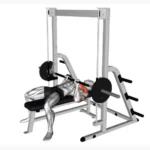Standing Barbell Front Raise Overview
The standing barbell front raise is a highly effective exercise for targeting the anterior (front) deltoids, contributing to stronger and more defined shoulders. This movement also engages the upper chest and trapezius muscles, making it a valuable addition to shoulder workouts, upper-body routines, or full-body strength programs. Using a barbell allows for heavier loads compared to dumbbells, promoting greater muscle overload and strength gains.
The front deltoids play a key role in pressing movements, so strengthening them can enhance performance in exercises like bench presses or overhead presses. From an aesthetic perspective, well-developed front deltoids create a broader, more balanced upper-body appearance. Suitable for all fitness levels, this exercise is ideal for building shoulder strength and improving posture. Incorporate standing barbell front raises to sculpt powerful shoulders and boost functional fitness.
Standing Barbell Front Raise Instructions
- Select Equipment: Choose a barbell and load it with a weight that challenges you but allows controlled movement. Beginners should start with a light barbell (or an empty bar) to focus on form.
- Position Your Body: Stand with feet shoulder-width apart for stability, knees slightly bent to reduce lower-back strain. Engage your core, keep your chest lifted, and maintain a neutral spine with shoulders retracted.
- Grip the Barbell: Grasp the barbell with an overhand (pronated) grip, hands shoulder-width apart. Hold the bar in front of your thighs, arms fully extended with a slight bend in the elbows.
- Initiate the Raise: Brace your core and slowly lift the barbell forward and upward, keeping your arms nearly straight and elbows slightly bent to avoid joint stress.
- Reach Peak Height: Raise the bar until your arms are parallel to the ground (shoulder height), ensuring the movement is driven by your shoulders, not momentum. Pause briefly to engage the front deltoids.
- Lower the Bar: Slowly lower the barbell back to the starting position in a controlled manner, maintaining tension in your shoulders and avoiding swinging.
- Repeat: Perform 3 sets of 10-12 reps, resting 60-90 seconds between sets. Focus on smooth, deliberate movements for optimal results.
Standing Barbell Front Raise Tips
- Control the Movement: Avoid using momentum or leaning back to lift the barbell. Keep your torso stationary to isolate the front deltoids effectively.
- Maintain Form: Keep a slight bend in your elbows throughout to reduce joint strain and ensure the shoulders do the work.
- Slow Tempo: Use a controlled tempo (e.g., 2 seconds up, 2 seconds down) to maximize time under tension and enhance muscle activation.
- Breathing Technique: Inhale as you prepare to lift and exhale as you raise the barbell, inhaling again as you lower it to maintain rhythm and core stability.
- Shoulder Alignment: Avoid shrugging your shoulders toward your ears to prevent trapezius overuse. Keep shoulders relaxed and retracted.
- Start Light: Begin with a lighter weight to perfect form before progressing to heavier loads to avoid injury.
- Grip Variations: Experiment with a slightly wider or narrower grip to find the most comfortable position for your arm length and shoulder mobility.
- Progress Gradually: Increase weight or reps as strength improves, but prioritize form to maximize results and minimize risk.
Benefits: The standing barbell front raise builds stronger, more defined front deltoids, enhances shoulder stability, and improves performance in pressing exercises. It also contributes to a broader upper-body appearance and supports functional movements like lifting or reaching.
Building front delts with barbell raises? See their role in our Ultimate Guide to Muscle Groups for shoulder strength.






